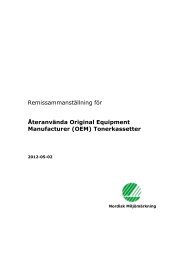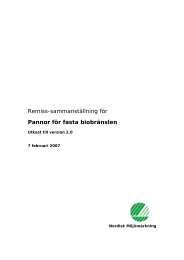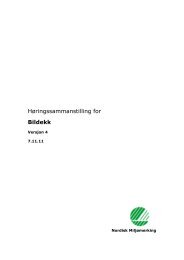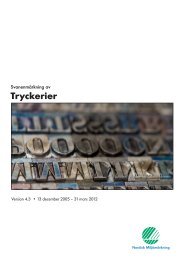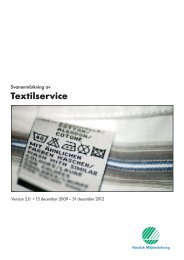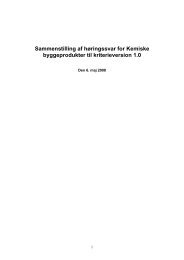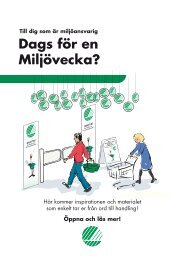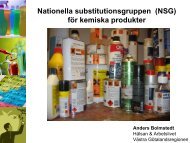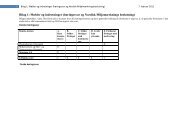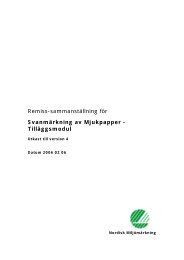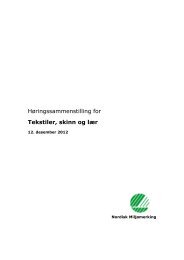Småhus, flerbostadshus och förskolebyggnader - Svanen
Småhus, flerbostadshus och förskolebyggnader - Svanen
Småhus, flerbostadshus och förskolebyggnader - Svanen
Create successful ePaper yourself
Turn your PDF publications into a flip-book with our unique Google optimized e-Paper software.
Nordisk Miljømerking<br />
Hus, leiligheter og barnehager 089/versjon 2<br />
Høringssammenstilling, oppdatert 10. august 2010<br />
The results from the copper risk assessment have contributed to the selection of national<br />
priority substances under the Water Framework Directive in Finland and in Sweden,<br />
resulting in the exclusion of copper.<br />
Useful considerations, addressed in the copper risk assessment, are:<br />
- Copper is an essential element for all life forms and therefore organisms need<br />
copper to ensure normal growth and development. Nature and humans both have<br />
natural regulating systems for copper allowing for adequate uptake/elimination, in<br />
accordance to nutritional needs. The Predicted No Effects Concentrations<br />
(PNECs), set in the copper risk assessment report, recognise copper excess, as<br />
well as copper deficiency. They integrate up to date science on copper<br />
bioavailability, in line with the REACH and Water Framework Directive<br />
guidelines.<br />
- Copper emissions into water systems have actually decreased drastically during<br />
the past decades due to:<br />
(1) the introduction of industrial on-site treatment plants;<br />
(2) the introduction of municipal waste water treatment plants;<br />
(3) better optimisation of fertiliser usage<br />
- These lower emissions have also resulted in decreased levels of copper in rivers,<br />
lakes and coastal waters. Monitoring data, covering surface waters throughout<br />
Sweden, has demonstrated that today’s copper levels are typically below 1 µg/l.<br />
Copper concentrations in the Baltic Sea have drastically decreased between 1978<br />
and 1996 (see figure 1) and are now typically around 0.6 µg/l. HELCOM further<br />
assessed copper time series (> 15 years) in Biota (herring, cod fish liver and<br />
mussels) and concluded that “copper levels have remained stable during the<br />
assessment period”. Some variations were observed and related to natural<br />
homeostasis factors rather than to anthropogenic activities. The HELCOM report<br />
also concluded that copper concentrations in blue mussels from Denmark and<br />
Sweden were lower than the ones reported at the reference sites and lower than<br />
the concentrations levels regarded as “high” background levels. These data clearly<br />
demonstrate the success of historical risk reduction measures and do not indicate a<br />
need for further market restrictions.<br />
- Copper roofs represent one of the smallest diffuse sources of copper in the EU<br />
environment, only 1%. By far the largest source is agricultural chemicals.<br />
- Due to general increased air quality, runoff from roofs has decreased. Over 15<br />
years, runoff levels have been extensively studied at the Royal Institute of<br />
Technology’s Dept. of Corrosion Science in Stockholm. In addition to long term<br />
field studies, a mathematical model has been created to predict copper releases.<br />
Results show that these are in fact very small and have (kommentar: Can this be<br />
better quantified?) reduced, during the past decades, as the air SO2 content has<br />
reduced. The very small amount of copper which is released from the outer<br />
115 (165)



